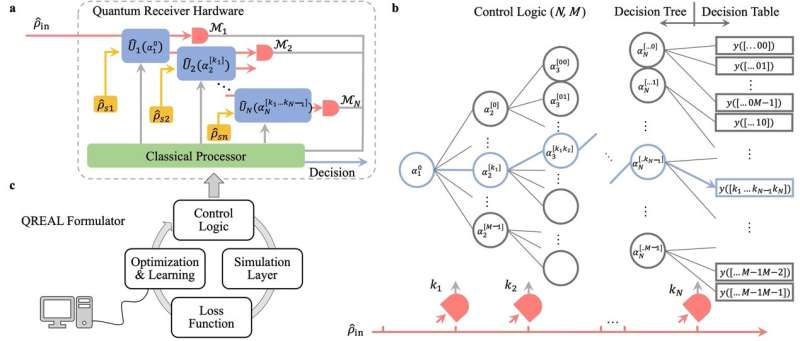A quantum receiver enhanced by adaptive learning

The quantum receiver is an elementary component in quantum information processing tasks. It aims to extract necessary information from non-orthogonal quantum states. Due to the nature of shot noise, signals carried by electromagnetic waves show non-orthogonal quantum features after suffering a severe loss, such as during interstellar communication. Therefore, the quantum receiver is the only apparatus to decode these weak signals with an error rate below the shot-noise limit.
However, conventional quantum receiver design is susceptible to noise. Additionally, the computational cost of analytically optimizing a suitable decoding logic is colossal. Hence, only a handful of quantum receivers have been designed for decoding basic codes, and their performances are still far from ideal.
In a new paper published in Light: Science & Applications, a group of researchers, led by associated professor Zheshen Zhang from the University of Arizona and the University of Michigan, and co-authors have developed a quantum receiver enhanced by adaptive learning technique (QREAL in short). By the concept of reinforcement learning, the upgraded quantum receiver now becomes self-guided and can iterate toward a better performance with the presence of noise.
The QREAL architecture comprises three functional cores: the hardware, the control logic, and the formulator. The hardware is based on a phase-locked Mech-Zehnder interferometer, a superconducting single-photon detector, and a classical processor. As a result, the optimized setup guarantees a record-high overall efficiency of around 85% and robust interference visibility of over 99.7%.
Loaded with the control logic, the classical processor handles all the hardware electronics. The control logic contains a decision tree and a decision table for decoding signal lively, which are learned by the formulator through hundreds of iterations of optimization and simulation. “Given the model of hardware, a targeted quantum information task, and possible noise sources, QREAL aims to learn a decoding protocol efficiently with an error rate as low as possible.”
In the experiments, researchers demonstrated its ability to learn a proper decoding protocol and adapt to noise automatically. The experimental results confirm that the performance improves by around 15% compared to conventional design methods and enjoys a 40% lower error rate than the best classical receiver.
For decoding binary phase-shifted keying, QREAL achieves less than a 2% error rate with less than one photon per code, which allows error correction and communication with such a low signal power. They also tested the QREAL in seeking the best protocol for decoding quadrature amplitude modulation signals with six codewords. “To the best of our knowledge, this is the first time a quantum receiver showing advantage with an alphabet larger than four.”
Since the researcher is no longer needed to pilot the platform, QREAL could be implemented in drone platforms for practical purposes such as Mars missions. Furthermore, due to its improved performance in mitigating noise patterns, the framework of QREAL may also benefit other noisy intermediate-scale quantum platforms. “It could become a new paradigm of quantum receiver design,” the scientists say.
More information:
Chaohan Cui et al, Quantum receiver enhanced by adaptive learning, Light: Science & Applications (2022). DOI: 10.1038/s41377-022-01039-5
Citation:
A quantum receiver enhanced by adaptive learning (2022, December 9)
retrieved 9 December 2022
from https://phys.org/news/2022-12-quantum.html
This document is subject to copyright. Apart from any fair dealing for the purpose of private study or research, no
part may be reproduced without the written permission. The content is provided for information purposes only.
For all the latest Science News Click Here
For the latest news and updates, follow us on Google News.

